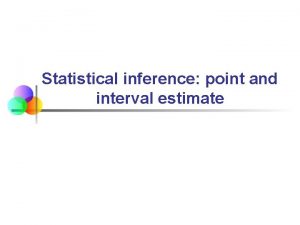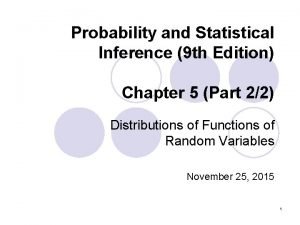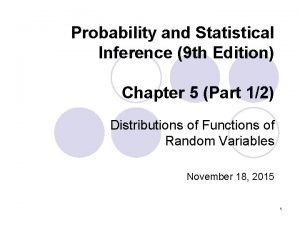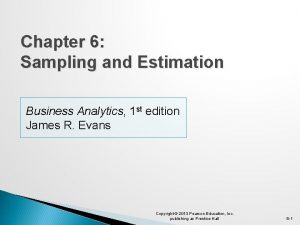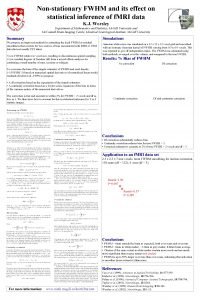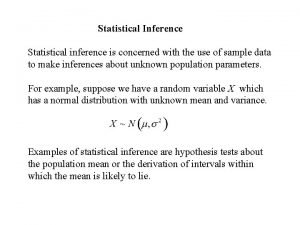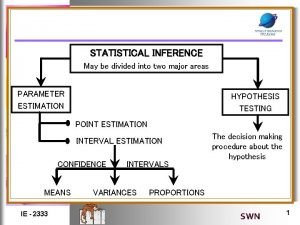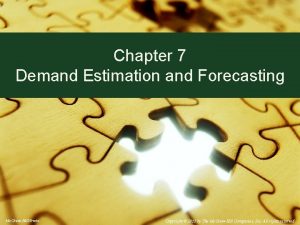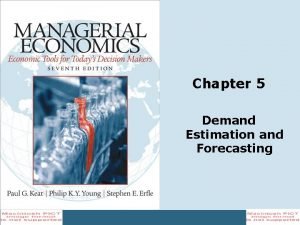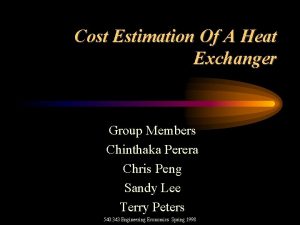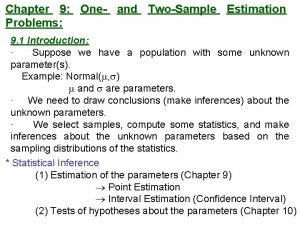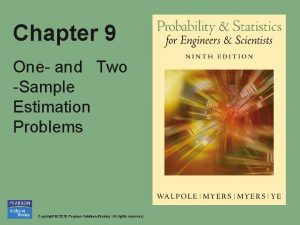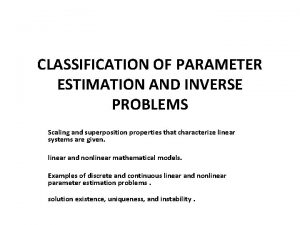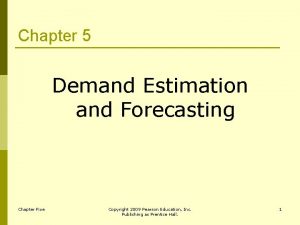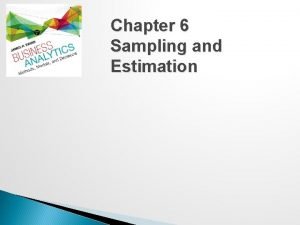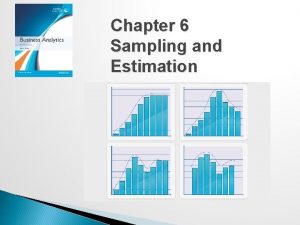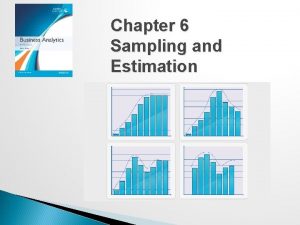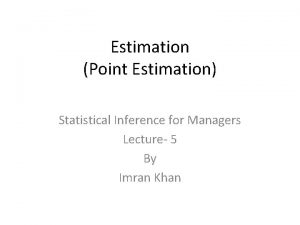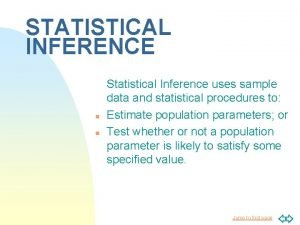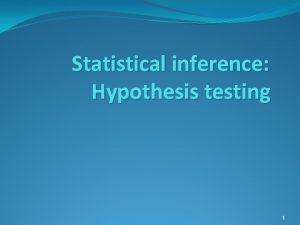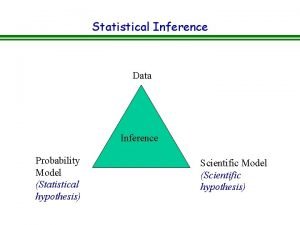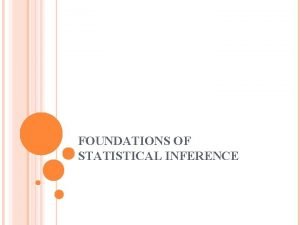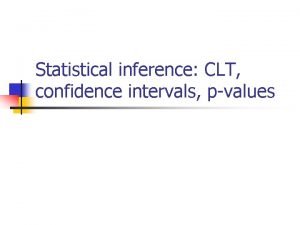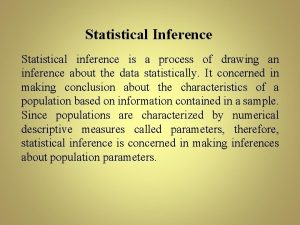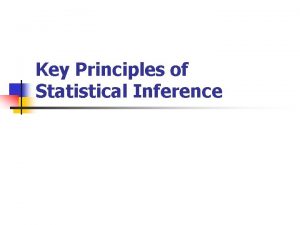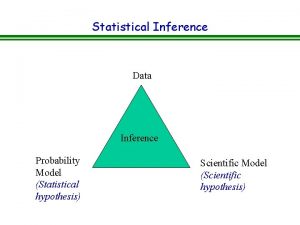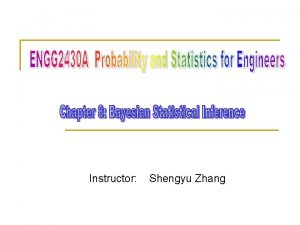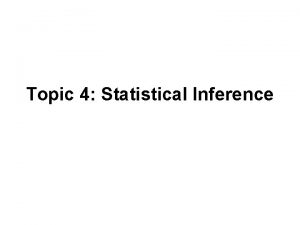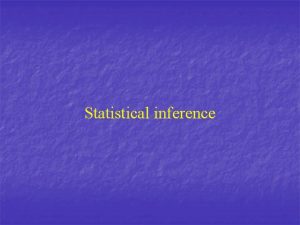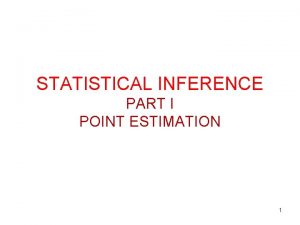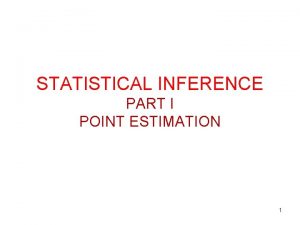II 2 Statistical Inference Sampling and Estimation A



















![Confidence Intervals Estimator T for an interval for parameter such that [T-a, T+a] is Confidence Intervals Estimator T for an interval for parameter such that [T-a, T+a] is](https://slidetodoc.com/presentation_image_h2/e2eebf8edff1ee897e3669dcb9295172/image-20.jpg)





- Slides: 25

II. 2 Statistical Inference: Sampling and Estimation A statistical model Μ is a set of distributions (or regression functions), e. g. , all uni-modal, smooth distributions. Μ is called a parametric model if it can be completely described by a finite number of parameters, e. g. , the family of Normal distributions for a finite number of parameters μ, σ: IR&DM, WS'11/12 October 25, 2011 II. 1

Statistical Inference Given a parametric model M and a sample X 1, . . . , Xn, how do we infer (learn) the parameters of M? For multivariate models with observed variable X and „outcome (response)“ variable Y, this is called prediction or regression, for a discrete outcome variable this is also called classification. r(x) = E[Y | X=x] is called the regression function. IR&DM, WS'11/12 October 25, 2011 II. 2

Idea of Sampling Distribution X Statistical Inference (e. g. , a population, objects of interest) Distrib. Param. μX N What can we say about X based on X 1, …, Xn? Sample Param. mean variance size Samples X 1, …, Xn drawn from X (e. g. , people, objects) n Example: Suppose we want to estimate the average salary of employees in German companies. Sample 1: Suppose we look at n=200 top-paid CEOs of major banks. Sample 2: Suppose we look at n=100 employees across all kinds of companies. IR&DM, WS'11/12 October 25, 2011 II. 3

Basic Types of Statistical Inference Given a set of iid. samples X 1, . . . , Xn ~ X of an unknown distribution X. e. g. : n single-coin-toss experiments X 1, . . . , Xn ~ X: Bernoulli(p) • Parameter Estimation e. g. : - what is the parameter p of X: Bernoulli(p) ? - what is E[X], the cdf FX of X, the pdf f. X of X, etc. ? • Confidence Intervals e. g. : give me all values C=(a, b) such that P(p C) ≥ 0. 95 where a and b are derived from samples X 1, . . . , Xn • Hypothesis Testing e. g. : IR&DM, WS'11/12 H 0 : p = 1/2 vs. H 1 : p ≠ 1/2 October 25, 2011 II. 4

Statistical Estimators A point estimator for a parameter of a prob. distribution X is a random variable derived from an iid. sample X 1, . . . , Xn. Examples: Sample mean: Sample variance: An estimator for parameter is unbiased if E[ ] = ; otherwise the estimator has bias E[ ] – . An estimator on a sample of size n is consistent if Sample mean and sample variance are unbiased and consistent estimators of μX and IR&DM, WS'11/12 October 25, 2011 . II. 5

Estimator Error Let be an estimator for parameter over iid. samples X 1, . . . , Xn. The distribution of is called the sampling distribution. The standard error for is: The mean squared error (MSE) for is: Theorem: If bias 0 and se 0 then the estimator is consistent. The estimator is asymptotically Normal if converges in distribution to standard Normal N(0, 1). IR&DM, WS'11/12 October 25, 2011 II. 6

Types of Estimation • Nonparametric Estimation No assumptions about model M nor the parameters θ of the underlying distribution X “Plug-in estimators” (e. g. histograms) to approximate X • Parametric Estimation (Inference) Requires assumptions about model M and the parameters θ of the underlying distribution X Analytical or numerical methods for estimating θ Method-of-Moments estimator Maximum Likelihood estimator and Expectation Maximization (EM) IR&DM, WS'11/12 October 25, 2011 II. 7

Nonparametric Estimation The empirical distribution function is the cdf that puts probability mass 1/n at each data point Xi: A statistical functional (“statistics”) T(F) is any function over F, e. g. , mean, variance, skewness, median, quantiles, correlation. The plug-in estimator of = T(F) is: Simply use IR&DM, WS'11/12 instead of F to calculate the statistics T of interest. October 25, 2011 II. 8

Histograms as Density Estimators Instead of the full empirical distribution, often compact data synopses may be used, such as histograms where X 1, . . . , Xn are grouped into m cells (buckets) c 1, . . . , cm with bucket boundaries lb(ci) and ub(ci) s. t. lb(c 1) = , ub(cm ) = , ub(ci ) = lb(ci+1 ) for 1 i<m, and freqf (ci ) = freq. F (ci ) = Example: X 1= 1 X 2= 1 X 3= 2 X 4= 2 X 5= 2 X 6= 3 … X 20=7 f. X(x) 5/20 4/20 3/20 2/20 1 2 3 4 5 6 1/20 7 x Histograms provide a (discontinuous) density estimator. IR&DM, WS'11/12 October 25, 2011 II. 9

Parametric Inference (1): Method of Moments Suppose parameter θ = (θ 1, …, θk ) has k components. Compute j-th moment: j-th sample moment: for 1 ≤ j ≤ k Estimate parameter by method-of-moments estimator and … and s. t. … (for the first k moments) Solve equation system with k equations and k unknowns. Method-of-moments estimators are usually consistent and asymptotically Normal, but may be biased. IR&DM, WS'11/12 October 25, 2011 II. 10

Parametric Inference (2): Maximum Likelihood Estimators (MLE) Let X 1, . . . , Xn be iid. with pdf f(x; θ). Estimate parameter of a postulated distribution f(x; ) such that the likelihood that the sample values x 1, . . . , xn are generated by this distribution is maximized. Maximum likelihood estimation: Maximize L(x 1, . . . , xn; ) ≈ P[x 1, . . . , xn originate from f(x; )] Usually formulated as Ln( ) = ∏i f(Xi; ) Or (alternatively) Maximize ln( ) = log Ln( ) The value that maximizes Ln( ) is the MLE of . If analytically untractable use numerical iteration methods IR&DM, WS'11/12 October 25, 2011 II. 11

Simple Example for Maximum Likelihood Estimator Given: • Coin toss experiment (Bernoulli distribution) with unknown parameter p for seeing heads, 1 -p for tails • Sample (data): h times head with n coin tosses Want: Maximum likelihood estimation of p Let L(h, n, p) with h = ∑i Xi Maximize log-likelihood function: log L (h, n, p) IR&DM, WS'11/12 October 25, 2011 II. 12

MLE for Parameters of Normal Distributions IR&DM, WS'11/12 October 25, 2011 II. 13

MLE Properties Maximum Likelihood estimators are consistent, asymptotically Normal, and asymptotically optimal (i. e. , efficient) in the following sense: Consider two estimators U and T which are asymptotically Normal. Let u 2 and t 2 denote the variances of the two Normal distributions to which U and T converge in probability. The asymptotic relative efficiency of U to T is ARE(U, T) : = t 2/u 2. Theorem: For an MLE and any other estimator the following inequality holds: That is, among all estimators MLE has the smallest variance. IR&DM, WS'11/12 October 25, 2011 II. 14

Bayesian Viewpoint of Parameter Estimation • Assume prior distribution g( ) of parameter • Choose statistical model (generative model) f (x | ) that reflects our beliefs about RV X • Given RVs X 1, . . . , Xn for the observed data, the posterior distribution is h ( | x 1, . . . , xn ) For X 1= x 1, . . . , Xn= xn the likelihood is which implies (posterior is proportional to likelihood times prior) MAP estimator (maximum a posteriori): Compute that maximizes h( | x 1, …, xn ) given a prior for . IR&DM, WS'11/12 October 25, 2011 II. 15

Analytically Non-tractable MLE for parameters of Multivariate Normal Mixture Consider samples from a k-mixture of m-dimensional Normal distributions with the density (e. g. height and weight of males and females): with expectation values and invertible, positive definite, symmetric m m covariance matrices Maximize IR&DM, WS'11/12 log-likelihood function: October 25, 2011 II. 16

Expectation-Maximization Method (EM) Key idea: When L(X 1, . . . , Xn, θ) (where the Xi and are possibly multivariate) is analytically intractable then • introduce latent (i. e. , hidden, invisible, missing) random variable(s) Z such that • the joint distribution J(X 1, . . . , Xn, Z, ) of the “complete” data is tractable (often with Z actually being multivariate: Z 1, . . . , Zm) • iteratively derive the expected complete-data likelihood by integrating J and find best : EZ|X, [J(X 1, …, Xn, Z, )] IR&DM, WS'11/12 October 25, 2011 II. 17

EM Procedure Initialization: choose start estimate for (0) (e. g. , using Method-of-Moments estimator) Iterate (t=0, 1, …) until convergence: E step (expectation): estimate posterior probability of Z: P[Z | X 1, …, Xn, (t)] assuming were known and equal to previous estimate (t), and compute EZ|X, θ(t) [log J(X 1, …, Xn, Z, (t))] by integrating over values for Z M step (maximization, MLE step): Estimate (t+1) by maximizing (t+1) = arg maxθ EZ|X, θ[log J(X 1, …, Xn, Z, )] Convergence is guaranteed (because the E step computes a lower bound of the true L function, and the M step yields monotonically non-decreasing likelihood), but may result in local maximum of (log-)likelihood function IR&DM, WS'11/12 October 25, 2011 II. 18

EM Example for Multivariate Normal Mixture Expectation step (E step): Zij = 1 if ith data point Xi was generated by jth component, 0 otherwise Maximization step (M step): IR&DM, WS'11/12 October 25, 2011 See L. Wasserman, p. 121 ff. for k=2, m=1 II. 19
![Confidence Intervals Estimator T for an interval for parameter such that Ta Ta is Confidence Intervals Estimator T for an interval for parameter such that [T-a, T+a] is](https://slidetodoc.com/presentation_image_h2/e2eebf8edff1ee897e3669dcb9295172/image-20.jpg)
Confidence Intervals Estimator T for an interval for parameter such that [T-a, T+a] is the confidence interval and 1– is the confidence level. For the distribution of random variable X, a value x (0< <1) with is called a -quantile; the 0. 5 -quantile is called the median. For the Normal distribution N(0, 1) the -quantile is denoted . For a given a or α, find a value z of N(0, 1) that denotes the [T-a, T+a] conf. interval or a corresponding -quantile for 1– . IR&DM, WS'11/12 October 25, 2011 II. 20

Confidence Intervals for Expectations (1) Let x 1, . . . , xn be a sample from a distribution with unknown expectation and known variance 2. For sufficiently large n, the sample mean is N( , 2/n) distributed and is N(0, 1) distributed: For confidence interval or then look up (z) to find 1–α IR&DM, WS'11/12 confidence level 1 - set October 25, 2011 II. 21

Confidence Intervals for Expectations (2) Let X 1, . . . , Xn be an iid. sample from a distribution X with unknown expectation and unknown variance 2 and known sample variance S 2. For sufficiently large n, the random variable has a t distribution (Student distribution) with n-1 degrees of freedom: with the Gamma function: IR&DM, WS'11/12 October 25, 2011 II. 22

Summary of Section II. 2 • Quality measures for statistical estimators • Nonparametric vs. parametric estimation • Histograms as generic (nonparametric) plug-in estimators • Method-of-Moments estimator good initial guess but may be biased • Maximum-Likelihood estimator & Expectation Maximization • Confidence intervals for parameters IR&DM, WS'11/12 October 25, 2011 II. 23

Normal Distribution Table IR&DM, WS'11/12 October 25, 2011 II. 24

Student‘s t Distribution Table IR&DM, WS'11/12 October 25, 2011 II. 25
 Interval estimate example
Interval estimate example Chebyshev's inequality
Chebyshev's inequality Probability and statistical inference 9th solution pdf
Probability and statistical inference 9th solution pdf Sampling and estimation methods in business analytics
Sampling and estimation methods in business analytics Statistical inference
Statistical inference Statistical inference is concerned with
Statistical inference is concerned with Statistical inference is divided into
Statistical inference is divided into Sampling method in research
Sampling method in research Panel sampling
Panel sampling Convenience sampling images
Convenience sampling images Contoh event sampling adalah
Contoh event sampling adalah Stratified sample vs cluster sample
Stratified sample vs cluster sample Non-probability sampling
Non-probability sampling Natural sampling vs flat top sampling
Natural sampling vs flat top sampling Advantages of glucose oxidase method
Advantages of glucose oxidase method Sewage and storm water estimation
Sewage and storm water estimation Demand forecasting in managerial economics
Demand forecasting in managerial economics Estimation of power wiring system
Estimation of power wiring system Demand estimation and forecasting
Demand estimation and forecasting Demand estimation and forecasting
Demand estimation and forecasting Heat exchanger price estimation
Heat exchanger price estimation One and two sample estimation problems
One and two sample estimation problems One and two sample estimation problems
One and two sample estimation problems Cost theory and estimation
Cost theory and estimation Parameter estimation and inverse problems
Parameter estimation and inverse problems Demand estimation and forecasting
Demand estimation and forecasting
